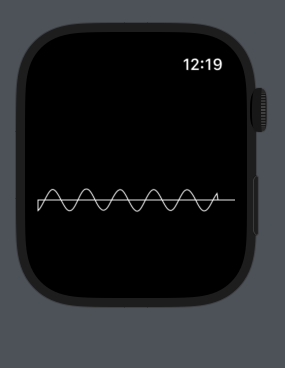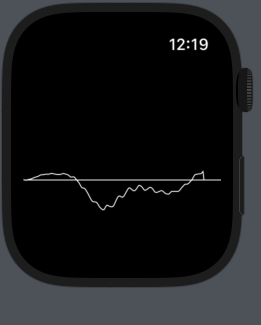캡스톤디자인 5주차 중간발표
5주차 발표 - Audio Engine in Apple Watch
Apple Watch에서의 Audio Engine의 가동과정, 한계, 문제점
CustomCanvasView.swift
import SwiftUI
import UIKit
import CoreGraphics
import WatchKit
import AVFAudio
class CountRepo : ObservableObject {
@Published var count : Int = 0
}
class ArrayRepo : ObservableObject {
@Published var cgArray = [CGFloat](repeating: 0, count: 1024)
}
class PathRepo : ObservableObject {
@Published var newPath : Path!
}
struct CustomCanvasView: View {
var audioTest : AudioTest
/** 실시간 렌더링을 위한 Observer 변수.*/
@ObservedObject var testArray = ArrayRepo()
static var cgFloat = [CGFloat](repeating: CGFloat(0), count: 1024)
var cgContext : CGContext
var image : UIImage!
var deviceWidth : CGFloat!
var deviceHeight : CGFloat!
@ObservedObject var path = PathRepo()
@State var testNum : Int = 2
//@ObservedObject var testNum = CountRepo()
var device : WKInterfaceDevice
// 여기서부턴 오디오 변수
var avAudioEngine : AVAudioEngine // 오디오 엔진 선언
var avAudioNodeBus : AVAudioNodeBus // 오디오 노드 선언(채널 1번째 선언할 예정) - 스테레오
var inputFormat: AVAudioFormat! // AudioTest 클래스 초기화 시 AVAudioEngine의 .inputNode.inputFormat(forBus : avAudioNodeBus)로 선언하게 된다.
var avAudioPCMBuffer : AVAudioPCMBuffer // 오디오 PCM 버퍼를 선언하게 된다. (pcmFormat : inputFormat, frameCapacity : 배열 크기)
var avAudioTime : AVAudioTime
//var int16data : UnsafePointer<UnsafeMutablePointer<Int16>>?
//var avAudioNodeTapBlock : AVAudioNodeTapBlock
//var avAudioInputNode = AVAudioInputNode.initialize()
//var customCanvas
//var testNum : String
var session = AVAudioSession()
init() {
self.audioTest = AudioTest()
/** 현재 애플워치 디바이스의 가로, 높이 속성을 가져오기 위함 */
self.device = WKInterfaceDevice.current()
self.deviceWidth = device.screenBounds.width
self.deviceHeight = device.screenBounds.height
// 여기서부턴 오디오 변수
self.session = AVAudioSession.sharedInstance()
print("Input Latancy : ")
print(session.inputLatency)
self.avAudioEngine = AVAudioEngine()
print(avAudioEngine.inputNode.latency)
self.avAudioNodeBus = AVAudioNodeBus(0)
self.inputFormat = avAudioEngine.inputNode.inputFormat(forBus: avAudioNodeBus) /* inputFormat에 어느 노드버스가 들어가는지 넣는다.*/
self.avAudioPCMBuffer = AVAudioPCMBuffer(pcmFormat: inputFormat, frameCapacity: 250)! /* pcm 형성 시, inputFormat형태, 그리고 1024개의 배열로 배출된다.*/
self.avAudioTime = AVAudioTime(sampleTime: 5000, atRate: 44100)
engineStart()
}
mutating func engineStart(){
//avAudioEngine.prepare()
//inputFormat = avAudioEngine.inputNode.inputFormat(forBus: avAudioNodeBus)
//var customCanvas = CustomCanvas
//var testNum = testNum
print("engineStart()")
/** AudioEngine 라이브러리는 AudioNode라는 구조체를 통해 정보를 받는다. */
var avAudioNodeTapBlock : AVAudioNodeTapBlock = { [self]
(buffer : AVAudioPCMBuffer, when : AVAudioTime) in
/** 비동기 작업 실행 코드들*/
var floatData : UnsafePointer<UnsafeMutablePointer<Float>>! = (buffer.floatChannelData)
var floatDatas = [CGFloat](repeating: 0.000000, count: 250)
/** 디바이스의 크기보다 약간 낮은 180까지로 진행 */
for num in 0..<180 {
/** 데이터가 0.999... ~ -0.999... 까지이므로 디스플레이에 표현하기 위해 숫자를 키운다. */
floatDatas[num] = CGFloat(floatData[0][num] * 1000)
}
/** 주소를 바로 넘기는 것이 최적화에 좋다 판단. */
self.testArray.cgArray = floatDatas
/** CGPath같은 이미지는 View에 삽입이 불가능하므로, View에 넣을 수 있는 Path로 "일단" 대체 */
self.path.newPath = Path{ path in
path.move(
to: CGPoint(
x : 0,
y : 0
)
)
for num in 0..<Int(self.deviceWidth) {
path.addLine(to: CGPoint(x: CGFloat(num), y: self.testArray.cgArray[num]))
}
/** closeSubPath()를 실행해야 여기서 마무리 한다는 것을 알린다. */
path.closeSubpath()
/** 디스플레이 크기가 작으므로 선 굵기는 1,
왼쪽 상단이 (0, 0) 위치이므로, offSet 변경 */
}.strokedPath(StrokeStyle(lineWidth: 1)).offsetBy(dx: 0, dy: self.deviceHeight/2)
/** 실시간 변동을 확인하기 위해 넣었던 테스트 넘버 */
self.testNum = self.testNum + 1
print(self.testNum)
//print(when.sampleTime) // 9.999999747378752e-05
//print(when.sampleRate) // 48000.0
//print(when.sampleTime) // 32534953
//print(when.audioTimeStamp)
/**
AudioTimeStamp(
mSampleTime: 32539753.0,
mHostTime: 436679309415,
mRateScalar: 1.0,
mWordClockTime: 105553156162144, mSMPTETime: __C.SMPTETime(mSubframes: -12224, mSubframeDivisor: 11392, mCounter: 1, mType: __C.SMPTETimeType, mFlags: __C.SMPTETimeFlags(rawValue: 1),
mHours: -23152,
mMinutes: 28617,
mSeconds: 1, mFrames: 0),
mFlags: __C.AudioTimeStampFlags(rawValue: 7),
mReserved: 1)
*/
}
do {
/** AudioEngine은 기본적으로 AudioNode를 기반으로 실행하기 때문에,
노드에 커스텀한 변수들을 넣는다. */
avAudioEngine.inputNode.installTap(onBus: avAudioNodeBus, bufferSize: 250, format: inputFormat, block: avAudioNodeTapBlock)
//CustomCanvas = customCanvas
avAudioEngine.prepare() // AudioEngine 시작 전 prepare()은 필수입니다.
try avAudioEngine.start() // 시작!
print("complete")
} catch {
fatalError("starting AVAudioEngine is fail")
}
}
/** 나중에 Path 라이브러리 대신 BitMapImage 생성을 위해 남겨놓은 코드
mutating func draw() -> Path {
self.path.newPath = Path{ path in
path.move(
to: CGPoint(
x : 0,
y : 0
)
)
path.addLine(
to: CGPoint(x: 180 , y: 180)
)
path.addLine(
to: CGPoint(x: 50, y: 70)
)
path.closeSubpath()
}.strokedPath(StrokeStyle(lineWidth: 1))
/*
var newNum = Int(testNum)! + 1
self.testNum = String(newNum)
*/
return self.path.newPath
}
*/
var body : some View {
VStack{
self.path.newPath
}
}
}
struct CustomeCanvasView_Previews: PreviewProvider {
static var previews: some View {
CustomCanvasView()
}
}

